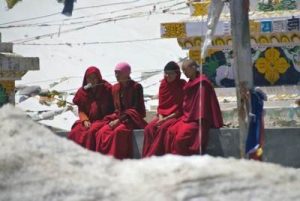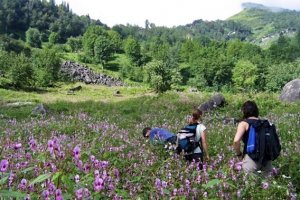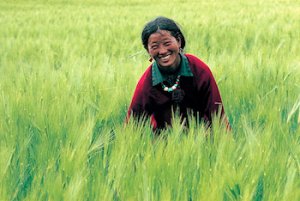Tours in Kullu & Spiti
Tours in Kullu & Spiti
About the Tours in Kullu & Spiti
Again, a small selection of our tours is listed below. Apart from several more itineraries in Spiti, we especially recommend the Himalaya crossings, either from Kinnaur or Kullu to Spiti, or from Lahul and Spiti to Ladakh. You can either do them on foot or by jeep. These are some of the most rewarding and spectacular of all treks and tours in the Himalayan region.
Also, we have started a series of easy to medium treks in the lower parts of the Himalayas: Kullu, Chamba, Brahmaur. These can be done 8 – 10 months per year. The same goes for a number of jeep tours in these areas, where you’ll be taken through a whole series of valleys and former kingdoms in the lower Himalayas from Dharamasala to Lahul.
Jeep Tours
Treks
SHORT STAYS
ABOUT Kullu & Spiti

The Indian state of Himachal Pradesh covers a wide range of areas and landscapes, all of them mountainous. From the foothills of the Himalayas you can travel to the many hill stations hidden among lush green pine woods, like Kangra, Manali or Shimla, the erstwhile summer residence of the British raj, and then continue (if you dare) to the highest peaks of the mighty Himalayan Range itself. All without leaving the state.
In earlier times, this was a conglomerate of small kingdoms like Kangra, Chamba and Kullu. You’ll pas a number of them while traveling by road to Ladakh on the other side of the Himalayas. Many travelers do, and forget that there is lots to be seen here as well. Especially in the winter season these areas are a very pleasant destination. They offer a great wealth of cultural diversity with both Hindu and Buddhist sights and pilgrimage places. Besides, they offer a range of trekking opportunities, generally not as strenuous as the treks in Ladakh, as they rarely exceed 4000m. The eastern parts of the state, the districts of Lahul and Spiti, straddle the Himalayan Range. Lahul is a popular departure point for treks to Zanskar and Ladakh. The less visited region of Spiti actually lies on the other side of world’s highest mountain range, being part of the Trans-Himalayas.
FOLLOW THE SADHUS AND THE SHEPHERDS

The forested slopes of the Kullu Valley are an excellent starting point for medium high and medium strenuous treks. It’sa true delight to trek up through these forests up to the flowering high meadows. You’ll share the trail with shepherds and saddhus. The latter are ‘holy man,’ Hindu ascetes that come to the mountains to meditate and visit holy shrines, temples and the origin of rivers. The alpine meadows are the domain of the gaddis.These shepherds lead a nomadic life, herding their flocks of sheep into the high mountain pastures once the snow melts and then returning to their isolated existence in the village.
More often then not, the majestic back-drop of the Himalayan glaciers makes the picture perfect. And, amazingly, most of these high meadows don’t see many trekkers on an average summer day, generally none. Due to new construction of roads some remote towns have become more accessible, which has not always improved their charm. But it has also opened up new possibilities for not-so-long treks. We’ve just discovered a few new routes that will not disappoint you.
SHANGRI-LA
Spiti is a true Shangri-La if there ever was one. Within India, it is the easiest place to reach by road that can give you the real Tibetan look and feel. Trust that you’ll be awed by the Spitians’ adaptation to their harsh environment and mesmerized by their Buddhist culture. Though nestled in a large meander of the mighty Himalayan Range on its dry northern side, it has always been closer – and, therefore, more exposed to – Tibet than to any place in India. In summer it can be approach from nearby Manali by crossing two high passes, the 4550 m high Kunzum La,
 marking the entry point to the Tibetan cultural realm. Even outside the summer season, when the Kunzum La is closed due to snow fall, Spiti can be accessed over a road that follows the Sutlej, as this big river has found an opening in the Himalayan Range.
marking the entry point to the Tibetan cultural realm. Even outside the summer season, when the Kunzum La is closed due to snow fall, Spiti can be accessed over a road that follows the Sutlej, as this big river has found an opening in the Himalayan Range.
HIGH ALTITUDE TREKKING
Spiti offers splendid high altitude trekking. You can do short treks or even day-walks where you walk from one small hamlet to the next. As Spiti has some of the highest permanently inhabited villages in the world – the villagers of Komik manage to grow barley at 4500 m – the views are phenomenal. You can also embank on a serious, hard but rewarding multi-day trek that involves negotiating glaciated passes of above 5000 m. In particular, trekking into Spiti is a very rewarding endeavour, as you literally cross from one world into another. Both the landscape and the culture change dramatically as you descend from one of the Himalayan passes into the vast expanse of the Tibetan Plateau.




